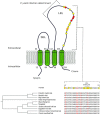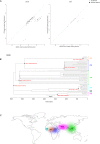Evolutionary Analysis Provides Insight Into the Origin and Adaptation of HCV
- PMID: 29765366
- PMCID: PMC5938362
- DOI: 10.3389/fmicb.2018.00854
Evolutionary Analysis Provides Insight Into the Origin and Adaptation of HCV
Abstract
Hepatitis C virus (HCV) belongs to the Hepacivirus genus and is genetically heterogeneous, with seven major genotypes further divided into several recognized subtypes. HCV origin was previously dated in a range between ∼200 and 1000 years ago. Hepaciviruses have been identified in several domestic and wild mammals, the largest viral diversity being observed in bats and rodents. The closest relatives of HCV were found in horses/donkeys (equine hepaciviruses, EHV). However, the origin of HCV as a human pathogen is still an unsolved puzzle. Using a selection-informed evolutionary model, we show that the common ancestor of extant HCV genotypes existed at least 3000 years ago (CI: 3192-5221 years ago), with the oldest genotypes being endemic to Asia. EHV originated around 1100 CE (CI: 291-1640 CE). These time estimates exclude that EHV transmission was mainly sustained by widespread veterinary practices and suggest that HCV originated from a single zoonotic event with subsequent diversification in human populations. We also describe a number of biologically important sites in the major HCV genotypes that have been positively selected and indicate that drug resistance-associated variants are significantly enriched at positively selected sites. HCV exploits several cell-surface molecules for cell entry, but only two of these (CD81 and OCLN) determine the species-specificity of infection. Herein evolutionary analyses do not support a long-standing association between primates and hepaciviruses, and signals of positive selection at CD81 were only observed in Chiroptera. No evidence of selection was detected for OCLN in any mammalian order. These results shed light on the origin of HCV and provide a catalog of candidate genetic modulators of HCV phenotypic diversity.
Keywords: CD81; equine hepacivirus; hepatitis C virus; molecular dating; positive selection; resistance-associated amino acid variants; tMRCA.
Figures






Similar articles
-
Differential Infection Patterns and Recent Evolutionary Origins of Equine Hepaciviruses in Donkeys.J Virol. 2016 Dec 16;91(1):e01711-16. doi: 10.1128/JVI.01711-16. Print 2017 Jan 1. J Virol. 2016. PMID: 27795428 Free PMC article.
-
Highly divergent hepaciviruses from African cattle.J Virol. 2015 Jun;89(11):5876-82. doi: 10.1128/JVI.00393-15. Epub 2015 Mar 18. J Virol. 2015. PMID: 25787289 Free PMC article.
-
Mice Expressing Minimally Humanized CD81 and Occludin Genes Support Hepatitis C Virus Uptake In Vivo.J Virol. 2017 Jan 31;91(4):e01799-16. doi: 10.1128/JVI.01799-16. Print 2017 Feb 15. J Virol. 2017. PMID: 27928007 Free PMC article.
-
The origin of hepatitis C virus.Curr Top Microbiol Immunol. 2013;369:1-15. doi: 10.1007/978-3-642-27340-7_1. Curr Top Microbiol Immunol. 2013. PMID: 23463195 Review.
-
Surveying the global virome: identification and characterization of HCV-related animal hepaciviruses.Antiviral Res. 2015 Mar;115:83-93. doi: 10.1016/j.antiviral.2014.12.014. Epub 2014 Dec 26. Antiviral Res. 2015. PMID: 25545071 Free PMC article. Review.
Cited by
-
Genomic insights into the secondary aquatic transition of penguins.Nat Commun. 2022 Jul 19;13(1):3912. doi: 10.1038/s41467-022-31508-9. Nat Commun. 2022. PMID: 35853876 Free PMC article.
-
Regulatory Role of Phospholipids in Hepatitis C Virus Replication and Protein Function.Pathogens. 2022 Jan 15;11(1):102. doi: 10.3390/pathogens11010102. Pathogens. 2022. PMID: 35056049 Free PMC article. Review.
-
CD56-negative NK cells: Frequency in peripheral blood, expansion during HIV-1 infection, functional capacity, and KIR expression.Front Immunol. 2022 Sep 23;13:992723. doi: 10.3389/fimmu.2022.992723. eCollection 2022. Front Immunol. 2022. PMID: 36211403 Free PMC article.
-
Host and HBV Interactions and Their Potential Impact on Clinical Outcomes.Pathogens. 2023 Sep 8;12(9):1146. doi: 10.3390/pathogens12091146. Pathogens. 2023. PMID: 37764954 Free PMC article. Review.
-
Evolutionary biology of human hepatitis viruses.J Hepatol. 2019 Mar;70(3):501-520. doi: 10.1016/j.jhep.2018.11.010. Epub 2018 Nov 23. J Hepatol. 2019. PMID: 30472320 Free PMC article. Review.
References
LinkOut - more resources
Full Text Sources
Other Literature Sources
Miscellaneous

